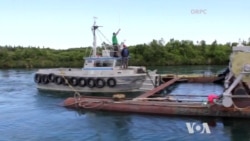ໃນຂະນະທີ່ກັງຫັນລົມ ແລະ ແຊລພະລັງງານແສງອາທິດ ຜະລິດພະລັງໄຟຟ້າໄດ້ແຕ່
ເວລາທີ່ມີລົມ ແລະ ແສງແດດເທົ່ານັ້ນ, ສ່ວນແມ່ນໍ້າສ່ວນໃຫຍ່ແມ່ນຈະໄຫຼຢູ່ບໍ່ເຊົາ
ແລະ ແຄມຝັ່ງທະເລສ່ວນຫຼາຍ ກໍແມ່ນມັກຈະມີຄື້ນຟອງຂອງມັນຢູ່ຕະຫຼອດ. ທີ່ກອງ
ປະຊຸມສຸດຍອດພະລັງງານ ເຊິ່ງຈັດຂຶ້ນໂດຍກະຊວງພະລັງງານ ສະຫະລັດ ນັ້ນ, ບໍລິ
ສັດແຫ່ງນຶ່ງ ໃນລັດ ເມນ ໄດ້ວາງສະແດງເຄື່ອງຈັກຜະລິດພະລັງງານໄຟຟ້າໃຕ້ນໍ້າລຸ້ນ
ໃໝ່ ທີ່ເກັບກ່ຽວພະລັງງານຢ່າງມີປະສິດທິຜົນຈາກແຄມແມ່ນໍ້າ ແລະ ຄື້ນທະເລ. ນັກ
ຂ່າວວີໂອເອ ຈໍຈ ພູຕິຈ ມີລາຍງານເພີ່ມເຕີມ, ເຊິ່ງ ພຸດທະສອນ ຈະນຳລາຍລະອຽດ
ມາສະເໜີທ່ານໃນອັນດັບຕໍ່ໄປ.
ແມ່ນໍ້າ ຄວີຈັກ ທີ່ມີກະແສນໍ້າໄຫຼແຮງ, ໃກ້ກັບບ້ານ ອີເກຍກິກ (Igiugig) ໃນເຂດຊົນ
ນະບົດຂອງລັດ ອາລັສກາ, ກັງຫັນຂະໜາດໃຫຍ່ ມີໃບພັດສອງໃບ ແມ່ນກຳລັງຖືກ
ຕິດຕັ້ງຢູ່ກັບບ່ອນຢ່າງຊ້າໆ.
ໃນເວລາບໍ່ດົນ ພື້ນຂອງມັນກໍໄດ້ຖືກນໍ້າຖ້ວມ, ເຮັດໃຫ້ໂຄງສ້າງຂອງມັນຈົມລົງພື້ນ
ນໍ້າຕື້ນ, ບ່ອນທີ່ກະແສນໍ້າສະໜອງພະລັງງານໃຫ້ແກ່ປະຊາຊົນທີ່ອາໄສຢູ່ໃນບ້ານ
ແຫ່ງນັ້ນ.
ລະບົບກັງຫັນ, ເອີ້ນວ່າ ຣິຟເຈັນ (RivGen) ແມ່ນຖືກຜະລິດໂດຍບໍລິສັດພະລັງ
ງານທົດແທນມະຫາສະໝຸດ ຫຼື, OPRC.
ທ່ານ ຄຣິສໂຕເຟີ ຊາວເອີ, ຜູ້ບໍລິຫານໃຫຍ່ຂອງບໍລິສັດ OPRC ກ່າວວ່າ “ມັນມີໂຄງ
ຮ່າງລວງນອນທີ່ຕໍ່າຫຼາຍ ສະນັ້ນມັນຈະເຮັດໃຫ້ ພວກເຮົາສົ່ງເທັກໂນໂລຈີຂອງພວກ
ເຮົາ ໄປບ່ອນທີ່ມັນຕື້ນກວ່າທີ່ຄົນ ອື່ນໆຈະສາມາດເຮັດໄດ້.”
ກັງຫັນ RivGen ປະຕິບັດງານໃນນໍ້າເລິກປະມານ 5 ແມັດ, ຜະລິດ ພະລັງງານໄດ້
ເຖິງ 50 ກິໂລວັດ, ປົກກະຕິແລ້ວ ຈະສະໜອງພະລັງງານພຽງພໍໃຫ້ແກ່ປະຊາຊົນ
ໃນຊຸມຊົນຂະໜາດນ້ອຍ. ທ່ານ ຊາວເອີ ກ່າວວ່າ ກັງຫັນດັ່ງກ່າວ ແມ່ນປອດໄພສຳ
ລັບສິ່ງແວດລ້ອມ.
ທ່ານ ຄຣິສໂຕເຟີ ຊາວເອີ ກ່າວວ່າ “ໃນລະດູທີ່ມີປາຊາລມັອນໜາແໜ້ນ, ພວກເຮົາ
ມີປາເກືອບ 2 ລ້ານໂຕ ລອຍຜ່ານເຄື່ອງຈັກນີ້ ແຕ່ຫຼັງຈາກນັ້ນ, ພວກເຮົາກໍບໍ່ໄດ້ເຫັນ
ປາ ແມ່ນແຕ່ໂຕດຽວໄດ້ຮັບບາດ ເຈັບ.”
ກັນຫັນທີ່ຕັ້ງລວງນອນສາມາດຂະຫຍາຍອອກກວ້າງ ເຊັ່ນເຄື່ອງນີ້, ມັນບໍ່ພຽງແຕ່ຈະ
ຖືກສົ່ງໄປໃນແມ່ນໍ້າເທົ່ານັ້ນ ແຕ່ກໍໄດ້ຖືກສົ່ງໄປອ່າວ ຄອບສຄຸກ (Cobscook) ຂອງ
ລັດ ເມນ (Maine) ເຊັ່ນກັນ, ເຊິ່ງເປັນທີ່ຮູ້ຈັກກັນດີ ສຳລັບຄື້ນນໍ້າ ທີ່ແຮງຂອງມັນ.
ແບບຂອງມັນແມ່ນມີປະສິດທິຜົນພິເສດຢູ່ທີ່ນີ້.
ທ່ານ ຄຣິສໂຕເຟີ ຊາວເອີ ກ່າວວ່າ “ດ້ວຍກັງຫັນລວງນອນນີ້, ມັນບໍ່ສຳຄັນວ່າ ນໍ້າ
ຈະມາ ຫຼື ໄປທາງໃດ, ມັນຈະໝູນໂຕໃນທິດທາງດຽວຕະຫຼອດ.”
ກັງຫັນ ໄທດເຈັນ (TidGen) ທີ່ມີຂະໜາດໃຫຍ່ກວ່າ ສາມາດຜະລິດພະລັງງານໄດ້
ເຖິງ 600 ເມກະວັດ. ແຮງໄຟຟ້າຂອງມັນ ຈະຂຶ້ນກັບຄວາມແຮງຂອງຄື້ນນໍ້າ ແລະ
ກະແສນໍ້າ, ແຕ່ດ້ວຍເຄື່ອງເອເລັກໂຕຣນິກເສີມນັ້ນ, ມັນສາມາດຢູ່ຄົງທີ່ ແລະ ດຳ
ເນີນງານພ້ອມກັນເພື່ອປະຕິກິລິຍາຂອງສາຍໄຟຟ້າໃຫຍ່.
ດ້ວຍລາຄາທີ່ຖືກ ກະໄວ້ປະມານ 50 ເຊັນ ຕໍ່ນຶ່ງກິໂລວັດໂມງນັ້ນ, ລະບົບດັ່ງກ່າວ
ແມ່ນບໍ່ສາມາດແຂ່ງຂັນໄດ້ ກັບແກ໊ສທຳມະຊາດ, ແຕ່ສຳລັບ ຊຸມຊົນໃນເຂດຊົນນະ
ບົດແລ້ວ, ບ່ອນທີ່ເຄື່ອງຈັກພະລັງງານກາຊວນ ແມ່ນມີລາຄາສູງກວ່າ 1 ໂດລາຕໍ່ຊົ່ງ
ໂມງ, ພະລັງງານຈາກກະແສນໍ້າ ແມ່ນອາດມີລາຄາຖືກກວ່າຕັ້ງຫຼາຍ.
While wind turbines and solar cells generate power only when there is wind and sun, most rivers always flow and most ocean shores always experience tidal currents. At a recent energy summit organized by the U.S. Energy Department, a company from Maine displayed an innovative submersible generator that effectively harvests power from shallow rivers and tidal currents. VOA's George Putic has more.
On the fast-flowing Kvichak River, close to the remote Alaskan village of Igiugig ((Pron: Eegi-ahgig)), a large horizontal turbine with two sets of blades is slowly being positioned into place.
Its pontoons soon were flooded, sinking the whole construction to the shallow bottom, where the river current will provide power for village residents.
The turbine system, called RivGen, is manufactured by Ocean Renewable Power Company, ORPC.
"It's got a very low vertical profile so it allows us to deploy our technology in sites that are much shallower than anybody else can do."
RivGen turbines work at depths of about five meters, generating up to 50 kilowatts, usually enough to power small communities. Sauer says the turbines are very safe for the environment.
"At the peak of salmon season, we had almost 2 million fish pass by this thing but at the end of all of that, we did not have a single fish injury that we knew about."
Horizontally-positioned turbines can be scaled to larger dimensions such as this one, deployed not in a river but in Maine's Cobscook Bay, known for its strong tidal currents. The design is especially efficient here.
"With crossflow turbines, it doesn't matter whether the water is coming or going, they always rotate in the same direction."
The larger TidGen ((Pron: Tide-gen)) turbine can generate up to 600 kilowatts. Its voltage varies as the tide ebbs and flows, but with additional electronics, it can be stabilized and synchronized to interact with the main grid.
With a projected price of about 50 cents per kilowatt-hour, the system is not competitive with natural gas, but for remote communities, where diesel generators cost more than $1 per hour, energy from flowing water could be more economical.










